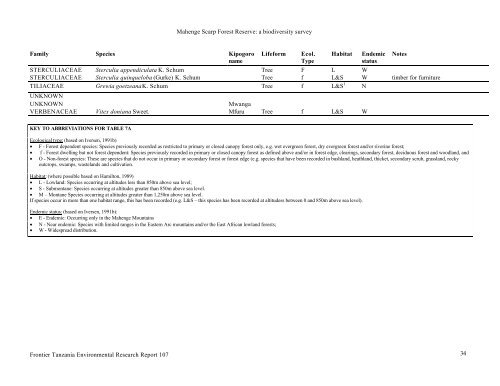Mahenge Scarp Forest Reserve - Frontier-publications.co.uk
Mahenge Scarp Forest Reserve - Frontier-publications.co.uk
Mahenge Scarp Forest Reserve - Frontier-publications.co.uk
Create successful ePaper yourself
Turn your PDF publications into a flip-book with our unique Google optimized e-Paper software.
<strong>Mahenge</strong> <strong>Scarp</strong> <strong>Forest</strong> <strong>Reserve</strong>: a biodiversity survey<br />
Family Species Kipogoro<br />
name<br />
Lifeform<br />
E<strong>co</strong>l.<br />
Type<br />
Habitat<br />
Endemic<br />
status<br />
STERCULIACEAE Sterculia appendiculata K. Schum Tree F L W<br />
STERCULIACEAE Sterculia quinqueloba (Gurke) K. Schum Tree f L&S W timber for furniture<br />
TILIACEAE Grewia goetzeanaK. Schum Tree f L&S 1 N<br />
UNKNOWN<br />
UNKNOWN<br />
Mwanga<br />
VERBENACEAE Vitex doniana Sweet. Mfuru Tree f L&S W<br />
Notes<br />
KEY TO ABBREVIATIONS FOR TABLE 7A<br />
E<strong>co</strong>logical type: (based on Iversen, 1991b)<br />
• F - <strong>Forest</strong> dependent species: Species previously re<strong>co</strong>rded as restricted to primary or closed canopy forest only, e.g. wet evergreen forest, dry evergreen forest and/or riverine forest;<br />
• f - <strong>Forest</strong> dwelling but not forest dependent: Species previously re<strong>co</strong>rded in primary or closed canopy forest as defined above and/or in forest edge, clearings, se<strong>co</strong>ndary forest, deciduous forest and woodland, and<br />
• O - Non-forest species: These are species that do not occur in primary or se<strong>co</strong>ndary forest or forest edge (e.g. species that have been re<strong>co</strong>rded in bushland, heathland, thicket, se<strong>co</strong>ndary scrub, grassland, rocky<br />
outcrops, swamps, wastelands and cultivation.<br />
Habitat: (where possible based on Hamilton, 1989)<br />
• L - Lowland: Species occurring at altitudes less than 850m above sea level;<br />
• S - Submontane: Species occurring at altitudes greater than 850m above sea level.<br />
• M – Montane Species occurring at altitudes greater than 1,250m above sea level.<br />
If species occur in more than one habitat range, this has been re<strong>co</strong>rded (e.g. L&S – this species has been re<strong>co</strong>rded at altitudess between 0 and 850m above sea level).<br />
Endemic status: (based on Iversen, 1991b):<br />
• E - Endemic: Occurring only in the <strong>Mahenge</strong> Mountains<br />
• N - Near endemic: Species with limited ranges in the Eastern Arc mountains and/or the East African lowland forests;<br />
• W - Widespread distribution.<br />
<strong>Frontier</strong> Tanzania Environmental Research Report 107 34

















